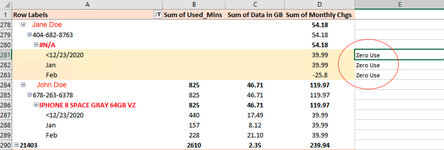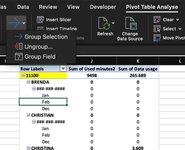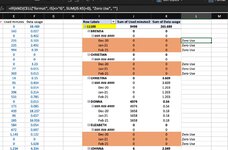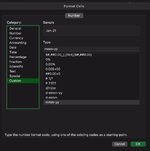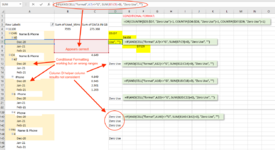Thanks in Advance:
The objective: Identify each mobile device user (and device) who hasn't used their device (at all) - i.e. no voice min. used and no data used over the past three consecutive months (as defined). Note: This is a monthly report so actual months change.
My column E will contain three consecutive instances of the returned value "Zero Use", sporadically, and as a result of conditions met in the formula below. Ex:
ROW COL E
281 Zero Use
282 Zero Use
283 Zero Use
The Question: In a script, how might I go about finding:
1) each 3 consecutively returned value instances of the term "Zero Use" and
2 then, once found - automatically highlight (relatively) the 3r x 4c just to the left of each instance (or in the case shown with E281) as shown in the attached image
=IF(AND(OR(A281="<12/23/2020",A281="Jan",A281="Feb"),AND(B281=0,C281=0)),"Zero Use","")=IF(AND(OR(A281="<12/23/2020",A281="Jan",A281="Feb"),AND(B281=0,C281=0)),"Zero Use","")
Note:: Formula is set for specific months but I'm thinking that doesn't have to be the case. i.e. any past tree consecutive months will satisfy the requirement.
The objective: Identify each mobile device user (and device) who hasn't used their device (at all) - i.e. no voice min. used and no data used over the past three consecutive months (as defined). Note: This is a monthly report so actual months change.
My column E will contain three consecutive instances of the returned value "Zero Use", sporadically, and as a result of conditions met in the formula below. Ex:
ROW COL E
281 Zero Use
282 Zero Use
283 Zero Use
The Question: In a script, how might I go about finding:
1) each 3 consecutively returned value instances of the term "Zero Use" and
2 then, once found - automatically highlight (relatively) the 3r x 4c just to the left of each instance (or in the case shown with E281) as shown in the attached image
=IF(AND(OR(A281="<12/23/2020",A281="Jan",A281="Feb"),AND(B281=0,C281=0)),"Zero Use","")=IF(AND(OR(A281="<12/23/2020",A281="Jan",A281="Feb"),AND(B281=0,C281=0)),"Zero Use","")
Note:: Formula is set for specific months but I'm thinking that doesn't have to be the case. i.e. any past tree consecutive months will satisfy the requirement.

